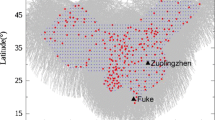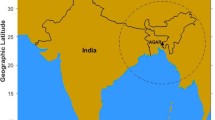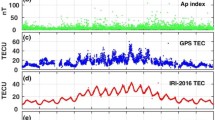Abstract
Using the global positioning system (GPS) measurements, the total electron content (TEC) at station Bangalore (13.02°N, 77.57°E geographic; 04.44°N, 150.84°E geomagnetic), lying at the equatorial region, and station Lucknow (26.91°N, 80.95°E geographic; 17.96°N, 155.24°E geomagnetic), lying at equatorial ionospheric anomaly (EIA) crest region, have been estimated for the year 2012–2013. In order to evaluate the International Reference Ionosphere (IRI) model regarding simulation/modeling of ionospheric studies specially at equatorial and EIA crest regions, we have compared the TEC derived from the recent version of the IRI-2012 model and the older IRI-2007 with its three topside options, namely IRI-NeQuick (IRI-NeQ), IRI-2001, and IRI01-corr, with that of GPS-TEC over Bangalore and Lucknow. For the EIA station Lucknow, the IRI-2012 model with IRI-NeQ and IRI01-corr topside is found in good agreement with GPS-TEC during summer and equinox season, while the IRI-2012 model for all three topside options significantly overestimates the GPS-TEC during winter season. The IRI-2001 topside overestimates the GPS-TEC over both the stations during all seasons. The anomalous difference between the IRI-2012 model prediction and ground-based GPS-TEC in daytime hours during the winter season observed at Lucknow could be attributed to discrepancies in the slab thickness predicted by the model, which is more during the winter season as compared to summer and equinox. These large discrepancies in the slab thickness predicted by the IRI-2012 as well as the IRI-2007 model during the winter season have been supported by using the foF2 data from Constellation Observing System for Meteorology, Ionosphere, and Climate radio occultation-based measurements. We also observed that the discrepancies in the recent IRI-2012 model with respect to GPS-TEC are found to be slightly larger than those with the older IRI-2007 model over the EIA region Lucknow. However, over the equatorial region Bangalore, the discrepancy with the older model IRI-2007 was found to be larger than with the recent IRI-2012 model. This suggests that the performance of the IRI-2012 model is poorer than the IRI-2007 model at the EIA region while better at equatorial region, and that further improvements in the IRI-2012 models are required particularly in the low-latitude and EIA regions. The GPS-TEC showed disappearance of the winter anomaly during 2012–2013, while the IRI model failed to predict the disappearance of winter anomaly.





Similar content being viewed by others
References
Abdu MA (2005) Equatorial ionosphere thermosphere system: electrodynamics and irregularities. Adv Space Res 35(5):771–787
Aggarwal M (2011) TEC variability near northern EIA crest and comparison with IRI model. Adv Space Res 48(7):1221–1231
Anderson DN, Mendillo M, Herniter B (1987) A semi-empirical low latitude ionospheric model. Radio Sci 22(2):292–306
Appleton EV (1946) Two anomalies in ionosphere. Nature 157:691–693
Bagiya MS, Joshi HP, Iyer KN, Aggarwal M, Ravindran S, Pathan BM (2009) TEC variations during low solar activity period (2005–2007) near the equatorial ionospheric anomaly crest region in India. Ann Geophys 27(3):1047–1057
Balan N, Shiokawa K, Otsuka Y, Kikuchi T, Vijaya Lekshmi D, Kawamura S, Yamamoto M, Bailey GJ (2010) A physical mechanism of positive ionospheric storms at low latitudes and mid-latitudes through observations and modeling. J Geophys Res 115:A02304
Balan N, Chen CY, Rajesh PK, Liu JY, Bailey GJ (2012) Modeling and observations of the low latitude ionosphere–plasmasphere system at long deep solar minimum. J Geophys Res 117:A08316
Balan N, Rajesh PK, Sripathi S, Tulasiram S, Liu JY, Bailey GJ (2013) Modeling and observations of the north–south ionospheric asymmetry at low latitudes at long deep solar minimum. Adv Space Res 52:375–382
Bhuyan PK, Borah RR (2007) TEC derived from GPS network in India and comparison with the IRI. Adv Space Res 39(5):830–840
Bilitza D (2001) International reference ionosphere 2000. Radio Sci 36(2):261–275
Bilitza D, Reinisch BW (2008) International reference ionosphere 2007: improvements and new parameters. Adv Space Res 42(4):599–609
Bilitza D, Altadill D, Zhang Y, Mertens C, Truhlik V, Richards P, McKinnel L-A, Reinisch B (2014) The international reference ionosphere 2012—a model of international collaboration. J Space Weather Space Clim 4(A07):1–12
Booker HG (1977) Fitting of multi region ionospheric profiles of electron density by a single analytic function of height. J Atmos Sol-Terr Phys 39(5):619–623
Chakraborty M, Kumar S, De BK, Guha A (2014) Latitudinal characteristics of GPS derived ionospheric TEC: a comparative study with IRI 2012 model. Ann Geophys 57(5):A0539
Chauhan V, Singh OP (2010) A morphological study of GPS-TEC data at Agra and their comparison with the IRI model. Adv Space Res 46:280–290
Coisson P, Radicella SM, Leitinger R, Nava B (2006) Topside electron density in IRI and NeQuick: features and limitations. Adv Space Res 37:937–942
Coisson P, Radicella SM, Ciralo L, Leitinger R, Nava B (2008) Global validation of IRI TEC for high and medium solar activity conditions. Adv Space Res 42:770–775
Daniell RE, Brown LD (1995) PRISM, a parameterized real-time ionospheric specification model Version 1.5. Computational Physics Inc., Newton
Ezquer R, Jadur C, de Gonzalez MM (1998) IRI-95 TEC predictions for the South American peak of the equatorial anomaly. Adv Space Res 22:811–814
Hofmann-Wellenhoff B, Lichtenegger H, Collins J (1992) Global Positioning system, Theory and Practice, 4th edn. Springer, Berlin 389 pp
Huang YN, Cheng K (1996) Solar cycle variation of equatorial ionospheric anomaly in total electron content in the Asian region. J Geophys Res 101:24513–24520
Jakowski N, Wehrenpfennig A, Heise S, Reigber C, Luehr H, Grunwaldt L, Meehan T (2002) GPS radio occultation measurements of the ionosphere from CHAMP: early results. Geophys Res Lett 29(10):95(1-4)
Kakinami Y, Liu J-Y, Tsai L-C (2012) A comparison of a model using the FORMOSAT-3/COSMIC data with the IRI model. Earth Planets Space 64(6):545–551
Kenpankho P, Watthanasangmecha K, Supnithi P, Tsugawa T, Maruyama T (2011) Comparison of GPS TEC measurements with IRI TEC prediction at the equatorial latitude station, Chumphon, Thailand. Earth Planets Space 63:365–370
Kumar S, Singh AK (2009) Variation of ionospheric total electron content in Indian low latitude region of equatorial ionization anomaly (EIA). Adv Space Res 43:555–1562
Kumar S, Priyadarshi S, Gopi Krishna S, Singh AK (2012) GPS-TEC variations during low solar activity period (2007–2009) at Indian low latitude stations. Astrophys Space Sci 339(1):165–178
Kumar S, Singh AK, Lee J (2014a) Equatorial Ionospheric Anomaly (EIA) and comparison with IRI model during descending phase of solar activity (2005–2009). Adv Space Res 53:724–733
Kumar S, Tan EL, Razul SG, See CMS, Siingh D (2014b) Validation of IRI-2012 model with GPS based ground observation over low-latitude Singapore station. Earth Planet Space 66:17
Kumar S, Tan EL, Murti DS (2015) Impacts of solar activity on performance of the IRI-2012 model predictions from low to mid latitudes. Earth Planet Space 67:42
Limberger M, Liang W, Schmidt M, Dettmering D, Hugentobler U (2013) Regional representation of F2 Chapman parameters based on electron density profiles. Ann Geophys 31:2215–2227
Lin CH, Liu JY, Fang TW, Chang PY, Rsai HF, Chen CH, Hsiao CC (2007) Motions of the equatorial ionization anomaly crests imaged by FORMOSAT-3/COSMIC. Geophys Res Lett 34:L19101
Martyn DF (1955) Physics of the ionosphere. The Physical Society, London 254 pp
Mukherjee S, Sarkar S, Purohit PK, Gwal AK (2010) Seasonal variation of total electron content at crest of equatorial anomaly station during low solar activity conditions. Adv Space Res 46(3):291–295
Nava B, Coisson P, Radicella SM (2008) A new version of the NeQuick ionosphere electron density model. J Atmos Solar Terr Phys 70(15):1856–1862
Rao BCN (1966) Control of equatorial Spread-F by the F layer height. J Atmos Terr Phys 28:1207–1217
Rao GS (2007) GPS satellite and receiver instrumental biases estimation using least squares method for accurate ionosphere modeling. J Earth Sys Sci 116(5):407–411
Rao PVSR, Krishna SG, Niranjan K, Prasad DSVVD (2006) Temporal and spatial variations in TEC using simultaneous measurements from the Indian GPS network of receivers during the low solar activity period of 2004–2005. Ann Geophys 24:3279–3292
Rastogi RG (1959) The diurnal development of the anomalous equatorial belt in the F2 region of the ionosphere. J Geophys Res 64(7):727–732
Rastogi RG, Sharma RP (1971) Ionospheric electron content at Ahmedabad (near the crest of equatorial anomaly) by using beacon satellite transmission during half a solar cycle. Planet Space Sci 19:1505–1517
Rathore VS, Kumar S, Singh AK (2015) A statistical comparison of IRI TEC prediction with GPS TEC measurement over Varanasi, India. J Atmos Solar Terr Phys 124:1–9
Sardón E, Rius A, Zarraoa N (1994) Estimation of the transmitter and receiver differential biases and the ionospheric total electron content from Global Positioning System observations. Rad Sci 29(3):577–586
Sridharan R, Pallam Raju D, Raghavarao R (1994) Precursor to equatorial spread-F in OI 630.0 nm day glow. Geophys Res Lett 21(25):2797–2800
Venkatesh K, Rama Rao PVS, Saranya PL, Prasad DSVVD, Niranjan K (2011) Vertical electron density and topside effective scale height (HT) variations over the Indian equatorial and low latitude stations. Ann Geophys 29:1861–1872
Yizengaw E, Moldwin MB, Galvan D, Iijima BA, Komjathy A, Mannucci AJ (2008) Global plasmaspheric TEC and its relative contribution to GPS TEC. J Atmos Solar Terr Phys 70(11–12):1541–1548
Yue X, William SS, Rocken C, Kuo Y-H (2013) Validate the IRI2007 model by the COSMIC slant TEC data during the extremely solar minimum of 2008. Adv Space Res 51:647–653
Zhang ML, Radicella SM, Shi JK, Wang X, Wu SZ (2006) Comparison among IRI, GPS-IGS and ionogram-derived total electron contents. Adv Space Res 37:972–977
Acknowledgments
The authors would like to express their gratitude to the University Corporation for Atmospheric Research (UCAR) and the National Space Organization (NSPO) in Taiwan for the availability of FORMOSAT‐3/COSMIC constellation data, as well as the International GNSS Service (IGS) for making available RINEX files. The research is partially supported by Indian Space Research Organization (ISRO), Bangalore, under the ISRO-SSPS program. We are grateful to reviewers for their valuable comments and suggestions which helped us to improve the manuscript.
Author information
Authors and Affiliations
Corresponding author
Rights and permissions
About this article
Cite this article
Kumar, S., Patel, K. & Singh, A.K. TEC variation over an equatorial and anomaly crest region in India during 2012 and 2013. GPS Solut 20, 617–626 (2016). https://doi.org/10.1007/s10291-015-0470-4
Received:
Accepted:
Published:
Issue Date:
DOI: https://doi.org/10.1007/s10291-015-0470-4




